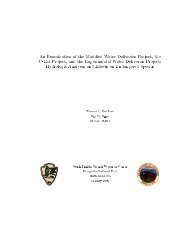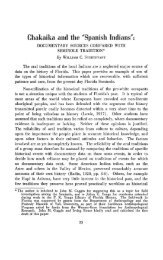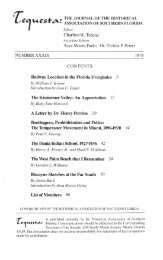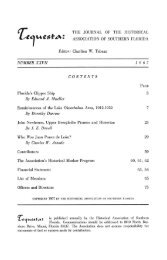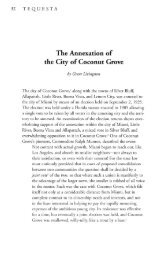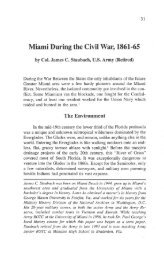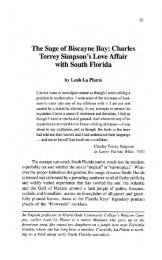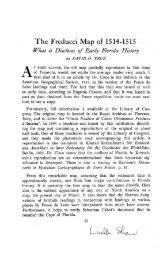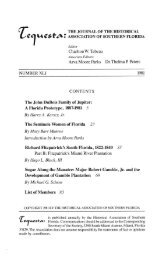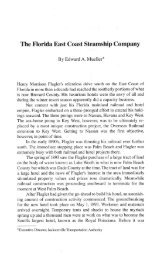Tequesta : Number - 50/1990 - FIU Digital Collections
Tequesta : Number - 50/1990 - FIU Digital Collections
Tequesta : Number - 50/1990 - FIU Digital Collections
You also want an ePaper? Increase the reach of your titles
YUMPU automatically turns print PDFs into web optimized ePapers that Google loves.
24 TEQUESTA<br />
In the beginning we had a dozen mango varieties, but over the years<br />
eliminated several, winding up with the Haden, Zill, Irwin, Morris and<br />
Keitt.<br />
We grew a number of citrus varieties but found grapefruit to be<br />
superior in quality to the oranges and tangerines, and the grapefruit trees<br />
had a more healthy appearance because they were less susceptible to<br />
insects and diseases.<br />
Considering the cost and the problems of growing dooryard citrus,<br />
I thought then (and still do) that the South Florida home owner might<br />
do well to limit his citrus production to limes, preferably the key lime.<br />
When they are in season, you can find Persian limes in the supermarket.<br />
But key limes are seldom grown commercially and are rarely sold<br />
except at a roadside stand. Thomless varieties are propagated and sold<br />
by nurserymen, but some old-time Conchs in the Florida Keys insisted<br />
on planting seedlings, claiming they were better producers. Seedlings<br />
may have so many thorns that picking the fruit becomes a problem. We<br />
grew key limes not so much to use in drinks but for Evelyn to make key<br />
lime pie.<br />
Among our most successful fruit trees were the lychees and jaboticabas.<br />
Two lychee trees we planted in the early 19<strong>50</strong>s grew rapidly; and<br />
in a few years were about equal in size to any in Dade County.<br />
Unfortunately they only yielded crops every other year. When they did<br />
produce, we had bushels of colorful fruit. The jaboticaba was more<br />
dependable, bearing its grape-like fruit along its trunk and branches two<br />
to three times a year. A very slow grower, the jaboticaba requires<br />
several years to reach fruiting size. In its early life, if planted in<br />
limestone soil, it may require applications of chelated iron to prevent its<br />
leaves from yellowing.<br />
In the early years much of the development of the landscape<br />
consisted of clearing saw palmettos to create open areas about the house<br />
and vistas that carried the eyes into the distance. Usually this wasn't too<br />
difficult, since we knew before building what kind of effect we wanted.<br />
First, we cleared the palmettos in the immediate area about the house.<br />
Then we opened a broad vista extending southeast to the swale. Since<br />
we knew a street eventually would be built along the west property line<br />
behind the house, we removed virtually all the palmettos in the northwest<br />
area and began establishing what was to be a dense screen along<br />
the west and the north borders. This screen, of large shrubs, small trees,<br />
and cluster-type palms, proved to be as esthetically satisfying as it was<br />
effective in cutting out the view of passing cars. We later extended this



